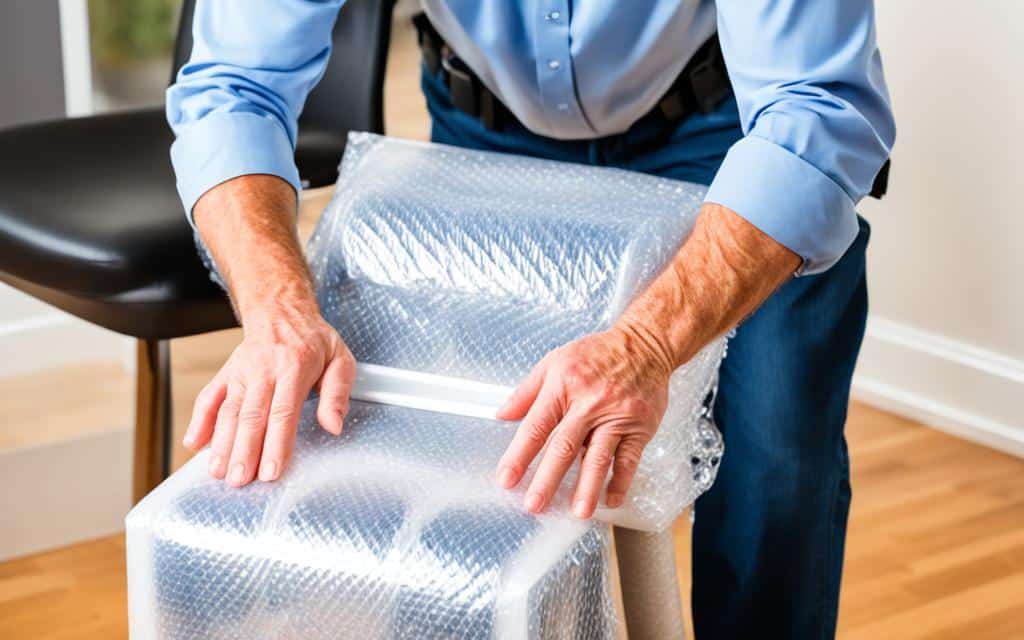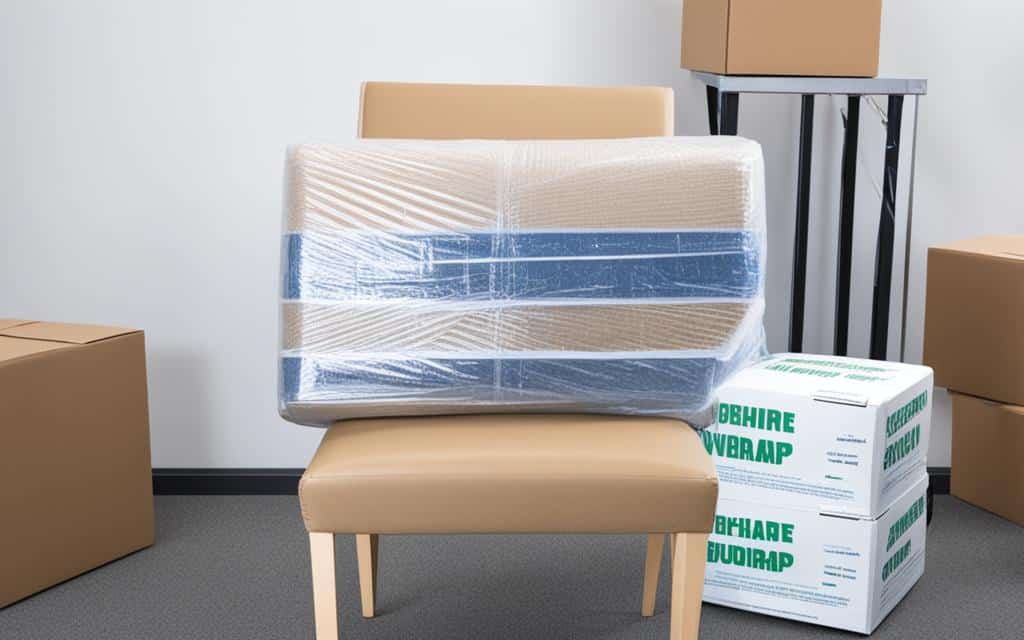As someone who deeply appreciates the comfort and support of a well-designed office chair, I understand the importance of keeping it safe during relocation.
Knowing the right chair wrapping techniques can make all the difference. Whether I’m preparing for a move across town or across the country, I’ve learned that how to protect chairs during relocation is key to preserving their condition.
With solid furniture moving tips, anyone can ensure their cherished seating arrives in pristine condition. After all, office chairs aren’t just another piece of furniture; they’re where we spend countless hours working, creating, and maybe even squeezing in a little fun.
Stick with me, and I’ll share some foolproof strategies to safeguard your office companion.
Preparing Your Chair for the Move
When I ponder about chair packaging for transportation, the first order of business is always to get acquainted with the chair’s design. Knowing where each bolt, cushion, and leg fits helps me wrap a chair for moving more effectively.
I think of it like getting to know a friend – understanding their quirks and character makes the whole process smoother. In this case, it’s the back splat, armrests, and the legs of my cherished dining chair that I need to tenderly care for.
Before the bubble wrap and moving blankets come out, I advocate for a good, thorough clean. A soft microfiber cloth is my weapon of choice – it’s gentle yet unforgiving to dust and allergens that might lurk on the chair’s surface.
Once I’ve given the chair a good once-over with this cloth, I pull out the vacuum. It’s surprising how much grime can get trapped in the crevices of a chair, but the crevice tool is perfect for sneaking into those tight spots, ensuring a clean slate for the next phase.
Armed with wisdom about each part of the chair, I can’t overstate the importance of the right supplies. For those nifty moving hacks for chairs, high-quality packing materials are non-negotiable.
My checklist? A plush moving blanket to swaddle the chair and sturdy packing tape to secure it all in place. I’m always extra vigilant the tape only touches the blanket – the last thing I want is a sticky residue assaulting the finish of my chair.

With the chair pristine and my supplies amassed, I can move onto the next step with confidence, knowing I’m ready to keep my beloved chair safe and secure.
Whether I’m passing through the threshold of a new home or easing into a new office space, my office chair will be right there with me, ready to continue supporting me through all my endeavors.
Stay tuned, and I’ll show you exactly how to wrap and shield your chair so expertly, you might just feel like a moving pro yourself.
How to Wrap a Chair for Moving
Embarking on a relocation journey entails ensuring the safety of your belongings, especially the furniture that serves as the cornerstone of comfort in your home.
I’ve adopted chair wrapping techniques that not only keep my trusty office chair protected but also lend me peace of mind. Whether you’re relocating across the street or the country, mastering chair protection during moving is essential.
Wrapping Without Disassembling
My preferred method for those who favor simplicity involves wrapping chairs without disassembly—this is one of the many moving hacks for chairs I’ve come to rely on.
I drape the chair on its back onto a generous moving blanket, ensuring the legs remain well within the blanket’s embrace.
Folding the corners neatly over the legs is key; secure placement is achieved by wrapping the top corners over and under the chair, taking care to keep all tape confined to the blanket to avoid marring the chair’s surface.
Detailed Disassembly Packing
For the more meticulous movers among us, disassembling a chair is the way to go. A methodical approach begins with a snapshot of the assembled chair—my handy blueprint for reassembly post-move.
Should the chair design permit, I tackle it piece by piece, separating wheels, armrests, and cushions. Each piece gets its protector in the form of bubble wrap and packing tape, followed by a layer of plastic wrap for that extra defense against the elements.
Labeling is the final, crucial step, and color-coded labels are my secret weapon to keep everything organized. With the chair packing methods I deploy, no component gets left behind or misplaced, and setting up my chair in the new space becomes a breeze.
Regardless of the method chosen, chair protection during moving is a combination of technique and attention to detail.
By employing these chair wrapping techniques, I can rest assured that my important furniture is shielded from the inevitable jostles and shuffles of a move, arriving ready for action in its new home.
FAQs
Q: What Are Some Effective Chair Wrapping Techniques For Moving?
A: Effective chair wrapping techniques include using moving blankets or pads to cover the chair, securing the padding with packing tape, shrink wrap, or straps, and ensuring all parts of the chair are well protected.
For chairs with delicate finishes, bubble wrap can be used before the moving blanket for extra protection. Make sure to tape only to the wrap and not directly on the chair’s surface to avoid damage.
Q: Can You Provide Some Furniture Moving Tips For Chairs?
A: Certainly! Always clean your chair thoroughly before moving. Disassemble if possible for easier transportation. Wrap each piece individually using moving pads and secure them.
Use a dolly to move heavy chairs without lifting them. Label the parts if disassembled so reassembly is easy. Stack chairs seat-to-seat for efficient use of space in the moving truck.
Q: How Should I Protect My Chairs During Relocation?
A: To protect your chairs during relocation, disassemble if possible and wrap each part individually. Use padded materials, like bubble wrap or moving blankets, to cover the chair surfaces, especially the corners and legs, which are prone to impact.
For upholstery, consider using a stretch wrap to keep the fabric clean and prevent snagging. Padding and careful stacking in the moving vehicle will also help prevent damage.
Q: What Are The Best Materials To Use For Chair Packaging For Transportation?
A: The best materials for chair packaging during transportation include moving blankets or furniture pads, bubble wrap for delicate areas, foam sheets for extra cushioning, plastic stretch wrap for keeping everything secure and clean, and packing tape to hold wraps in place.
Avoid taping directly onto the chair surface to prevent residue or damage to the finish.
Q: What Are Some Moving Hacks For Chairs To Simplify The Process?
A: Moving hacks for chairs include using sliders under the chair legs for easy movement across floors, stacking chairs seat-to-seat when loading onto a truck to save space, wrapping the legs with socks or small towels for quick padding, and taping screws and small parts underneath the chair seat or on a labeled bag to avoid losing them during the move.
Q: How Do I Wrap A Chair For Moving Without Disassembling It?
A: To wrap a chair without disassembling it, lay a large moving blanket on the ground and place the chair face down on top of it, with the back of the chair aligned with one edge of the blanket. Pull the blanket up and over the back, seat, and legs of the chair.
Then, fold in the sides of the blanket and secure them with packing tape. Make sure the tape does not make contact with the chair’s surface. Once wrapped, you can use shrink wrap around the entire chair for added stability.
Q: What Is The Detailed Disassembly Packing Method For Chairs?
A: Begin the detailed disassembly by taking pictures of the chair for reference. If possible, remove the legs, arms, cushions, and any detachable parts. Wrap each component in bubble or foam wrap, securing with tape. Overwrap with stretch plastic wrap for additional protection.
Label each part with a color-coded system, and keep small hardware in a labeled bag that can be attached to the main part of the chair or kept in a safe place until reassembly.
Q: Are There Specific Chair Packing Methods To Ensure Chair Protection During Moving?
A: Yes, specific chair packing methods to ensure protection include disassembling detachable parts and wrapping them individually, using the correct wrapping material like bubble wrap, foam, or moving blankets for various parts of the chair, and securing everything with packing tape or stretch wrap.
Avoid stacking heavy items on top of chairs in the moving truck and use cardboard cutouts or additional paddings to protect any protruding parts.

